About JAMU
Erasmus Charter for Higher Education 2014 – 2020
JAMU
The Janáček Academy of Performing Arts (JAMU) is a public higher education institution (HEI) founded 12th September 1947. Its beginnings had been preceded by efforts connected to the name of Leoš Janáček, including foundation of an organ school in 1881 and of the Brno Conservatory in 1919.
The JAMU´s main role is to provide tertiary education in the field of arts (music, theatre, dance, and multimedia) in its accredited study programmes. At the same time it actively pursues academic research and publication while striving to develop international partnerships. Students and teachers also participate in various programmes and take many opportunities to enhance their skills at partner foreign institutions With Erasmus+ alone, JAMU has contracts with c. 90 institutions from 30 countries.
LEOŠ JANÁČEK
Leoš Janáček is one of the most remarkable figures in the Czech as well as the world musical culture. He was born 3rd July 1854 in the town of Hukvaldy in Moravia as the ninth child of a rural teacher. He came to Brno at the age of eleven to acquire a thorough musical education in the newly founded Old Brno Monastery, and was closely connected to Brno all his life. As early as in 1870s in then provincial town, he devoted his professional life to organizing educational and artistic activities side by side with his own compositional activities. His compositional beginnings were influenced by Moravian folklore studies and later on by psychological aspects of human speech. Leoš Janáček composed nine operas and many vocal orchestral or instrumental pieces: Jenůfa, Káťa Kabanová, The Cunning Little Vixen, The Makropoulos Affair, From the House of the Dead, the Diary of One Who Disappeared, string quarters, wind sextet Youth, the Sinfonietta, and the Glagolitic Mass among others. The composer died 12th August 1928 in Ostrava and he is buried in the Central Cemetery in Brno.
THE CITY OF BRNO
With the population of 400,000, Brno is a city with long history and rich cultural traditions. Brno, the capital city of Moravia, came into being thanks to its position on merchant routes leading from the Alps to northern Europe. The history of Brno has a substantially central-European character (Czech and German elements merged together) and there is a clear influence from Vienna (the capital of Austria). Brno was given town rights in 1243 A. D. by King Václav I.
Brno is located in the south of Moravia, not far from Vienna. Brno is surrounded by beautiful countryside suitable for all kinds of sports – hiking, cycling, swimming, horse riding, etc. A lot of historical monuments, houses, churches and castles can be found both in Brno and its surroundings. The Moravian Karst, with its famous caves and abyss, is within easy reach of Brno. Brno is also close to the main folklore centres of Moravia, where traditions are still alive.
There are dozens of museums, theatres, galleries and clubs in the city of Brno. The most significant historic sites include the royal castle of Špilberk (13th century), St. Peter´s and St. Paul´s Cathedral (14th – 15th century) and the UNESCO world cultural heritage Villa Tugendhat (1928-1930) by L. M. van der Rohe.
